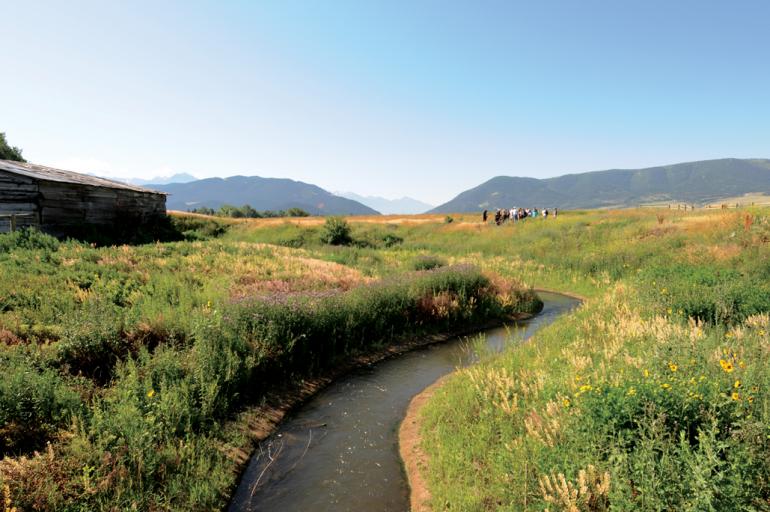Up a Creek
On a cool morning this past July, nearly 20 sixth and seventh graders from Sleeping Giant Middle School gathered on the Voyich Ranch in Livingston. They faced Fleshman Creek and Park High agriculture education teacher Kevin Fox.
Fox told them about the creek and the restoration work that helped return a dismal section of ditch into a sinewy stretch of water. After pointing out several species of invasive plants—spotted knapweed, burdock, morning glory, and others—Fox set them loose with work gloves and trash bags.
The kids ran along the hillside as if they were in a race, they dove under a barbed-wire fence, and they started pulling weeds. The students with the longest knapweed and the most weeds picked would win gift certificates for Blizzards at Dairy Queen.
Fleshman Creek is getting a major facelift. Numerous groups—Livingston School District, Park County, City of Livingston, U.S. Natural Resource Conservation Service, Montana Department of Environmental Quality, the Joe Brooks Chapter of Trout Unlimited, and many more—have pooled their talents, time, and money to restore the degraded creek with an important role.
Fleshman Creek starts near Bozeman Pass, flows roughly parallel to Interstate 90 and then through Livingston before dumping into the Yellowstone River at the end of 9th Street. Some of the water diverts into the lagoon in Sacajawea Park. It then flows behind Sleeping Giant Middle School and East Side Elementary before reaching the river at Mayor's Landing.
The goals of the restoration project are to develop a community resource, create and protect habitat, improve water quality, and reduce the creek's tendency to flood surrounding neighborhoods by restoring it to a more natural state. The creek is a major spawning tributary for Yellowstone cutthroat trout and an important habitat for myriad other species.
Fleshman Creek can be thought of as two distinct pieces of water, according to Todd Wester, curriculum director for the Livingston School District, and Livingston schools have been involved on projects on both sections.
“This is the best city-county-schools partnership I’ve ever been a part of,” Wester says. “It’s a really holistic effort.”
At Voyich Ranch the middle-schoolers were busy pulling knapweed and Canada thistle along a section where Park High students had planted 2,000 willows the previous spring. And before the high-school students came OASIS Environmental Inc. to engineer and manually reroute the creek.
“The students are gaining ownership of this stream,” says Fox. “They are getting hands-on science skills, learning about different career opportunities, and will think about this creek when issues like dumping oil down a storm drain come up.”
In 2004, Sleeping Giant students cleaned up trash and helped revegetate the area around Fleshman Creek at Mayor's Landing. They also did chemical testing on the water. In fact, Livingston students have been involved in water testing all along Fleshman Creek. The project is part of the curriculum in classes at both Sleeping Giant Middle School and Park High, so students participate in it throughout their academic career.
“You can learn a lot of things in the classroom,” Fox says, “but it’s great to get the kids out here and apply hands-on science principles in the real world.”
On August 4, Park County received a $2.28 million grant to fund the creek's flood-alleviation and restoration project. It was chosen from among 528 applicants. For more on the school efforts, visit livingston.k12.mt.us.













